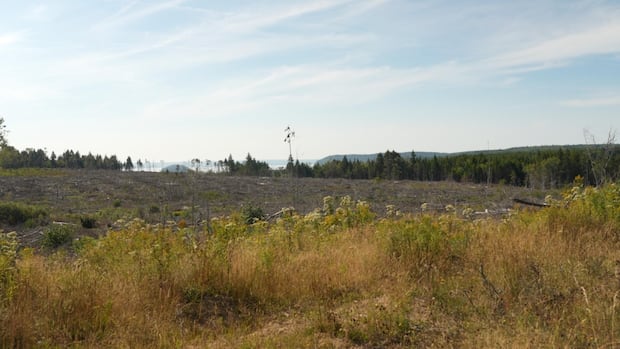Nova ScotiaIn previous years, the province made public where aerial spraying of the herbicide was happening but is no longer releasing that information.Forestry sector feels unfairly targeted by activists who’ve established encampments in years pastLuke Ettinger · CBC News · Posted: Sep 04, 2025 5:00 AM EDT | Last Updated: 9 hours agoGlyphosate is used by some woodlot owners two years after a clearcut to kill off undesirable tree species, allowing more profitable softwoods to grow faster. (Luke Ettinger/CBC)Activists are pushing for more information about where aerial spraying of glyphosate is happening after the Nova Scotia government has stopped releasing the locations for spraying of the herbicide by forestry companies.However the forestry sector says the use of the herbicide gets unfair attention, and identifying the locations draws protesters who block access to woodlots. Glyphosate is used by some woodlot owners to kill off species such as alders, aspen and pin cherry, reducing competition for more profitable softwood species and allowing them to grow faster. Previously, the provincial government provided premises identification (PID) numbers for where aerial sprays were approved. That didn’t happen when four approvals for spraying were issued in August.”We don’t have to tell everyone where these PIDs are, because what it does, it attracts people who don’t know the full story about forest management to actually show up in your private woodlot and roadblock your woodlot, and prevent you from managing your woodlot as you see fit,” said Todd Burgess, executive director of Forest Nova Scotia. There is still a requirement to post signs at entry points, tell residents within 500 metres, stay 30 metres away from water and only spray when wind speeds are below 10 kilometres per hour.”We are no longer sharing PID numbers for safety and security reasons. Making PID numbers public is not required under either federal or provincial regulations,” said Cindy Porter, a spokesperson for the Department of Environment. Savanna Callison submitted a freedom of information request for the spray site locations in August. “With the burn ban, people are not allowed to be in the woods, so it makes it really difficult to even look for the warning signs,” said Callison, who lives in Allen Hill, a community in Cumberland County.Last year, protesters in the Allen Hill area established an encampment on an approved spray site over concerns about the health and ecological impacts of glyphosate spraying.The RCMP responded to remove the protesters, but ultimately the spray did not go ahead. In August, Savanna Callison submitted a freedom of information request to receive aerial glyphosate spray site locations in Nova Scotia. (Luke Ettinger/CBC)”I don’t understand how we can justify spraying a substance that’s continuing to dry things out even further, when we clearly are seeing the driest conditions that we’ve had in many, many years,” said Callison of the current wildfire risk in Nova Scotia. Burgess said there is a short-term risk, but said a managed forest is a lower fire hazard over the course of decades. “If we’re going to go through the effort to plant trees so we can manage our forest, we want to make sure those trees are healthy and they remain healthy their entire lives,” he said. Health Canada reviewEcoJustice, a non-profit acting on behalf of four groups, filed a judicial review of Health Canada renewing the approval of the glyphosate product Mad Dog Plus in 2022. Earlier this year, the federal court found the non-rigorous assessment was reasonable, but ordered the department to revisit its approval of the product. Health Canada said the review of 61 studies did not change the existing risk assessment for glyphosate, and the product does not pose unacceptable risks to health or the environment when used as directed on the label.”Health Canada continues to monitor for new information related to all pesticides (including glyphosate) and will take appropriate action if there are reasonable grounds to believe that the use of the products is resulting in risks of concern to human health or the environment,” said Marie-Pier Burelle, a spokesperson for Health Canada. The product has not been used by the forestry sector in Cape Breton for decades. Neal Livingston, co-chair of the Margaree Environmental Association, was part of the efforts to block its use on the island and is hoping to see the same across Nova Scotia. “Maybe there might be one or two circumstances a year where somebody by doing extensive studies could absolutely justify why they need this. I doubt it,” Livingston said. Alexander Feix, the owner of a company that does aerial spraying and was contracted for the Allen Hill site, said glyphosate remains a valuable tool for the sector. The Tatamagouche business owner said he has received death threats and activists have trespassed onto land when it is not safe. “One of my clients had some work done on his land, and some of these people tracked down his wife’s phone number and called and were harassing her,” he said. For Feix, forestry is the “most regulated and most scrutinized” user of glyphosate, which is also used in agriculture and landscaping. “We’re one of the smallest users and use this treatment once in a rotation. So whether that be 40 to 60 years where agriculture and landscaping use it every year,” Feix said. ABOUT THE AUTHORLuke Ettinger is a reporter with CBC Nova Scotia based in Truro. Reach him at luke.ettinger@cbc.ca.
Activists question why Nova Scotia no longer disclosing glyphosate spray locations











